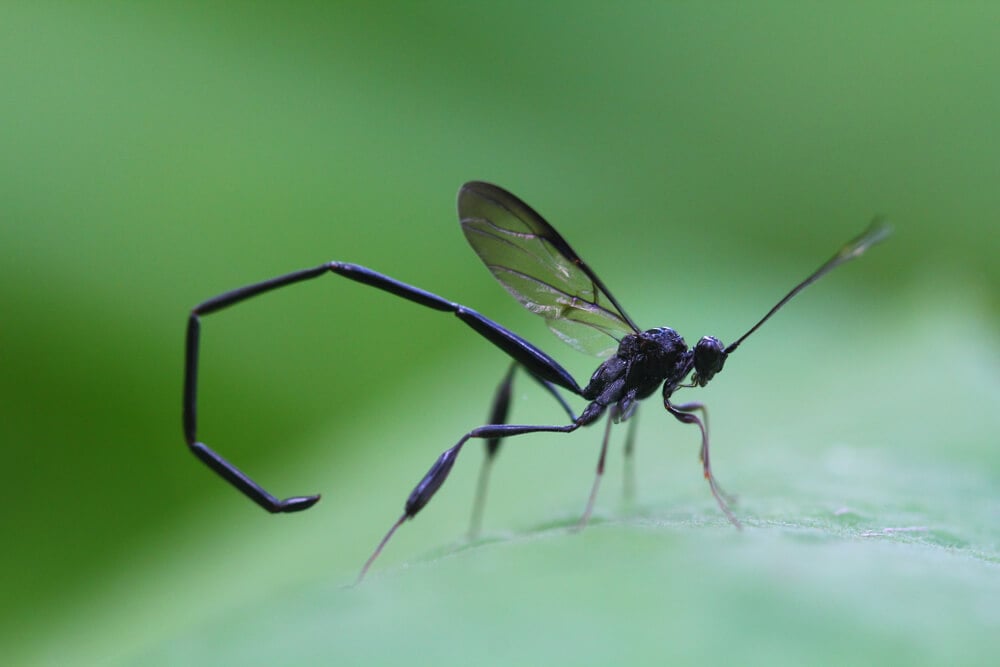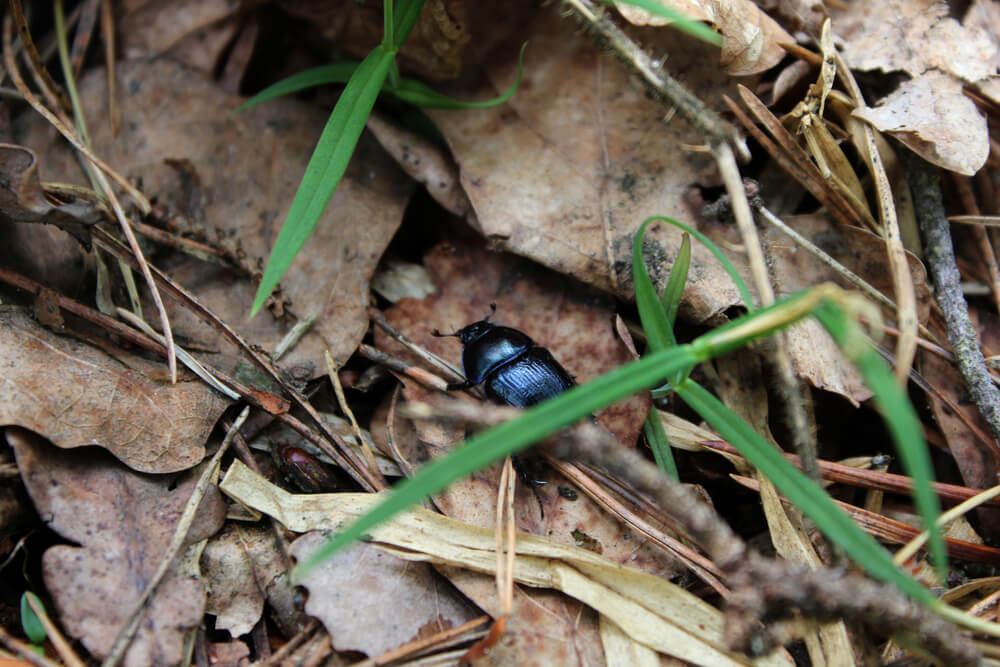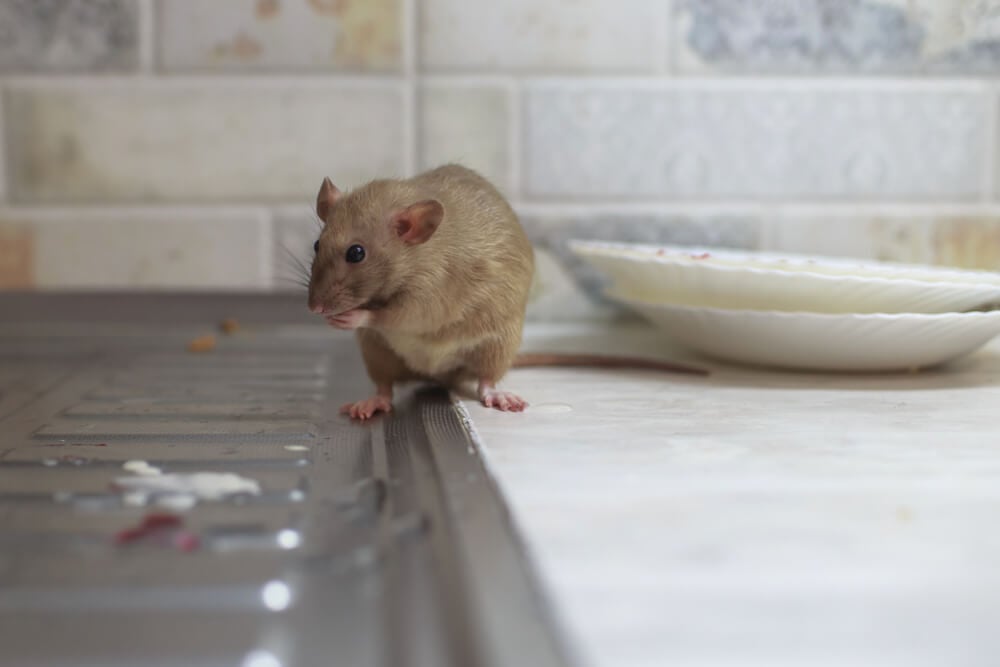Pelecinid Wasp
 Look, we said we’re not pulling punches. That’s why we’re starting with the thing that looks like a giant black wasp with a hook-like stinger longer than the rest of its body. Pelecinid wasps (Pelecinus polyturator) look like the wasps of some evil alternate dimension, like Australia. The pelecinid wasp is one of only three extant members of the ancient Pelecinidae family. It’s the only species of its kind found in North America, where it has a very wide habitation range. Adult Pelecinid wasps become active in the mid to late summer.
Some good news: that giant abdomen… hook... isn’t actually a stinger. Pelecinid wasps may jab at humans in self-defense if they’re cornered, but those jabs won’t break the skin. Pelecinid wasps actually use their long abdomens to probe soil for June bug grubs. When they find these subterranean grubs, pelecinid females pass eggs through their abdomens and lay them on the grubs directly. Newly hatched pelecinid wasps attach to the grubs as parasites until they mature. Despite their fearsome appearance and name, pelecinid wasps are totally harmless. Try to remind yourself the next time you see one. Good luck.
Look, we said we’re not pulling punches. That’s why we’re starting with the thing that looks like a giant black wasp with a hook-like stinger longer than the rest of its body. Pelecinid wasps (Pelecinus polyturator) look like the wasps of some evil alternate dimension, like Australia. The pelecinid wasp is one of only three extant members of the ancient Pelecinidae family. It’s the only species of its kind found in North America, where it has a very wide habitation range. Adult Pelecinid wasps become active in the mid to late summer.
Some good news: that giant abdomen… hook... isn’t actually a stinger. Pelecinid wasps may jab at humans in self-defense if they’re cornered, but those jabs won’t break the skin. Pelecinid wasps actually use their long abdomens to probe soil for June bug grubs. When they find these subterranean grubs, pelecinid females pass eggs through their abdomens and lay them on the grubs directly. Newly hatched pelecinid wasps attach to the grubs as parasites until they mature. Despite their fearsome appearance and name, pelecinid wasps are totally harmless. Try to remind yourself the next time you see one. Good luck.
Monkey Slugs
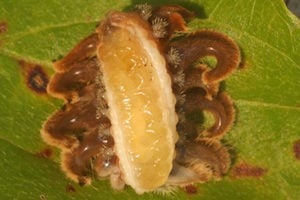 SPACE MONSTER! GET IT AWAY! Believe it or not, this monstrous mass of mottled brown fur, fuzz, and spines is actually a species of legless caterpillar, or larvae. The monkey slug caterpillar can grow up to 2.5 centimeters long. It has six pairs of curled, tentacle-like projections protruding from its flat central body. Despite their appearance, the monkey slug doesn’t use its tentacle “legs” to move. The larva’s entire body is covered in dense fur-like hair, which conceals the slug’s angled, poisonous spines. Unfortunately, we’re not done grossing you out quite yet. Flipping a monkey slug over reveals its even more disgusting, true body: a translucent yellow, snail-like belly covered in small legs. THESE legs are how the monkey slug moves. Lovely.
Monkey slug larvae somehow grow into the relatively normal-looking hag moth (Phobetron pithecium). You could spot monkey slugs or grown-up hag moths anywhere in the eastern, central, or northern US. They commonly infest rose, sassafras, and alder plants, as well as hickory, dogwood, spirea, and ash trees. Luckily, monkey slugs rarely become prevalent enough to qualify as a significant pest problem. They’re considered mostly a harmless (if disturbing) nuisance. Riiiight.
SPACE MONSTER! GET IT AWAY! Believe it or not, this monstrous mass of mottled brown fur, fuzz, and spines is actually a species of legless caterpillar, or larvae. The monkey slug caterpillar can grow up to 2.5 centimeters long. It has six pairs of curled, tentacle-like projections protruding from its flat central body. Despite their appearance, the monkey slug doesn’t use its tentacle “legs” to move. The larva’s entire body is covered in dense fur-like hair, which conceals the slug’s angled, poisonous spines. Unfortunately, we’re not done grossing you out quite yet. Flipping a monkey slug over reveals its even more disgusting, true body: a translucent yellow, snail-like belly covered in small legs. THESE legs are how the monkey slug moves. Lovely.
Monkey slug larvae somehow grow into the relatively normal-looking hag moth (Phobetron pithecium). You could spot monkey slugs or grown-up hag moths anywhere in the eastern, central, or northern US. They commonly infest rose, sassafras, and alder plants, as well as hickory, dogwood, spirea, and ash trees. Luckily, monkey slugs rarely become prevalent enough to qualify as a significant pest problem. They’re considered mostly a harmless (if disturbing) nuisance. Riiiight.
Cow Killer
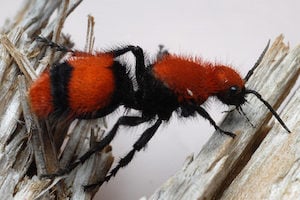 We feel like explaining why this thing is scary is unnecessary. It’s called a COW KILLER. This species of wasp is also sometimes called “velvet ants”, because the wingless females resemble large, furry ants with bright coloration. They comprise the Mutillidae family, which includes over 3,000 species. In other words, the nickname velvet ant doesn’t refer to one species, but rather a family of many species. Many species of wasps. Confused yet?
The most common cow killer wasp in the Midwest is the eastern velvet ant (Dasymutilla occidentalis). This wasp grows up to an inch long. Females resemble large ants and have a distinctive black-and-bright-red patterned coloration. They’re covered in dense hair. Males have less hair, orange coloration, and dark brown wings. Females don’t have wings, but they can use their ovipositor as a powerful stinger. This sting is so painful that it earned velvet ants their other frightening nickname. How painful is it? Entomologist and “King of Sting” Justin Schmidt ranked it as a 3 out of 4 on his famous pain scale. He has previously described a “3” as “spilling a beaker of hydrochloric acid on a paper cut.” Yikes.
If it makes you feel any better, literally every single part of the world has just as many freaky monster bugs as we do. Yes, every part of the world. What? That doesn’t make you feel better at all? Well, we tried. At least now you know about three spooky bugs you can use to freak out your friends. Y’know, pay the creepiness forward!
But before you get too freaked out, remember that your very own pest Van Helsing has your back. If you have issues with bugs this fall, call Plunkett’s and we’ll get them way before they can get you. Just give us a fair warning if it’s the cow killer, OK? Happy Halloween!
We feel like explaining why this thing is scary is unnecessary. It’s called a COW KILLER. This species of wasp is also sometimes called “velvet ants”, because the wingless females resemble large, furry ants with bright coloration. They comprise the Mutillidae family, which includes over 3,000 species. In other words, the nickname velvet ant doesn’t refer to one species, but rather a family of many species. Many species of wasps. Confused yet?
The most common cow killer wasp in the Midwest is the eastern velvet ant (Dasymutilla occidentalis). This wasp grows up to an inch long. Females resemble large ants and have a distinctive black-and-bright-red patterned coloration. They’re covered in dense hair. Males have less hair, orange coloration, and dark brown wings. Females don’t have wings, but they can use their ovipositor as a powerful stinger. This sting is so painful that it earned velvet ants their other frightening nickname. How painful is it? Entomologist and “King of Sting” Justin Schmidt ranked it as a 3 out of 4 on his famous pain scale. He has previously described a “3” as “spilling a beaker of hydrochloric acid on a paper cut.” Yikes.
If it makes you feel any better, literally every single part of the world has just as many freaky monster bugs as we do. Yes, every part of the world. What? That doesn’t make you feel better at all? Well, we tried. At least now you know about three spooky bugs you can use to freak out your friends. Y’know, pay the creepiness forward!
But before you get too freaked out, remember that your very own pest Van Helsing has your back. If you have issues with bugs this fall, call Plunkett’s and we’ll get them way before they can get you. Just give us a fair warning if it’s the cow killer, OK? Happy Halloween!

